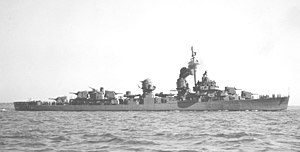USS Caperton (DD-650)
 |
|
| History | |
|---|---|
|
|
|
| Namesake: | William B. Caperton |
| Builder: | Bath Iron Works |
| Laid down: | 11 January 1943 |
| Launched: | 22 May 1943 |
| Commissioned: | 30 July 1943 |
| Decommissioned: | 27 April 1960 |
| Struck: | 1 December 1974 |
| Fate: | Sunk as a target in the 1980s |
| General characteristics | |
| Class and type: | Fletcher class destroyer |
| Displacement: | 2,050 tons |
| Length: | 376 ft 6 in (114.7 m) |
| Beam: | 39 ft 8 in (12.1 m) |
| Draft: | 17 ft 9 in (5.4 m) |
| Propulsion: |
|
| Speed: | 35 knots (65 km/h) |
| Range: |
|
| Complement: | 319 |
| Armament: |
|
USS Caperton (DD-650) was a Fletcher-class destroyer of the United States Navy, named for Admiral William B. Caperton (1850–1941).
Caperton was launched 22 May 1943 by Bath Iron Works, Bath, Maine, sponsored by Miss M. Caperton; and commissioned 30 July 1943, Commander W. J. Miller in command.
Caperton sailed from Boston 8 October 1943 for Pearl Harbor, where she arrived 6 November to begin the operations which would stamp her as one of the "fightingest" destroyers of the Pacific theater. After delivering explosives at Funafuti, Ellice Islands, 28–29 November, the destroyer covered the Gilbert Islands through patrol until 8 January 1944, when she put back to Pearl Harbor. Here she joined the screen of the mighty Fast Carrier Task Force, with which she steamed in the intensive series of operations which marked the advance of the Navy across the Pacific. (Then 5th Fleet's Task Force 58, later 3rd Fleet's TF 38.) On 30 January 1944, Caperton joined in the bombardment of Kwajalein, and from her base at Majuro, took part in the air strikes on Truk and Saipan in February.
...
Wikipedia
